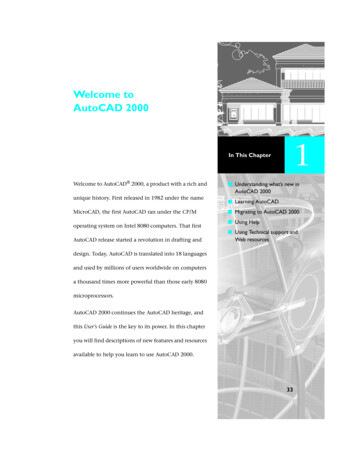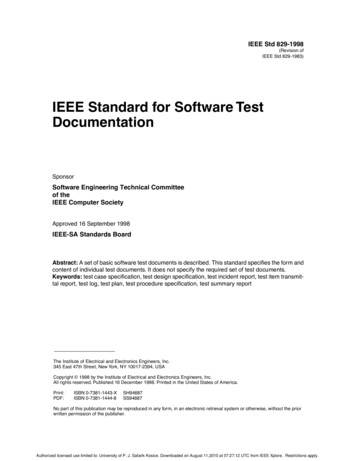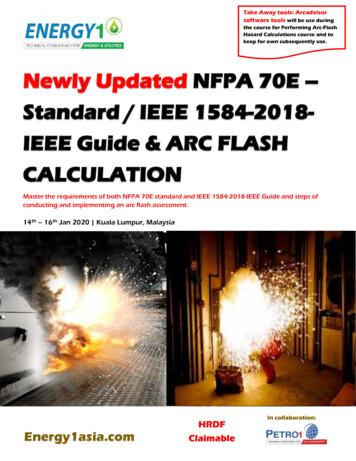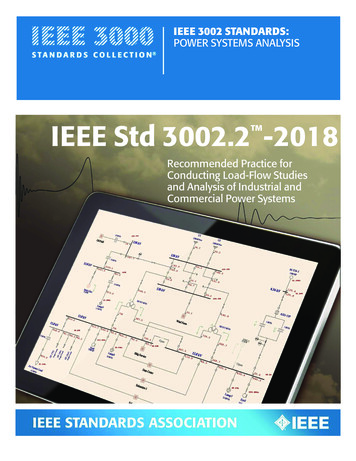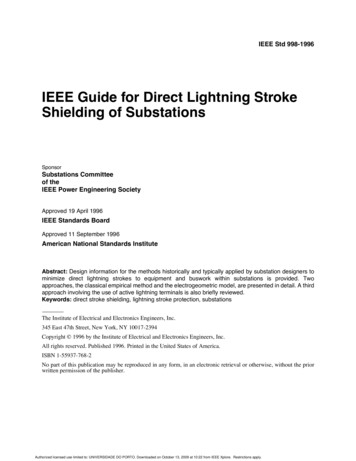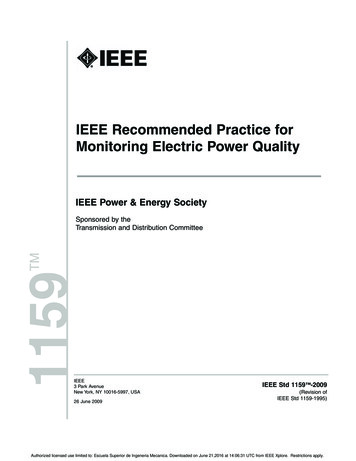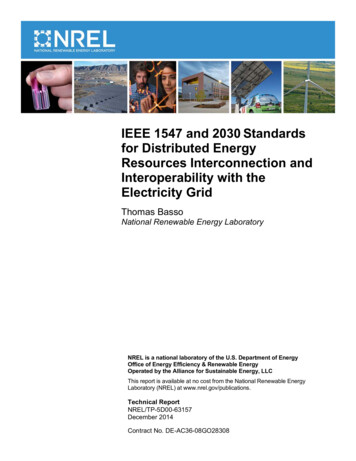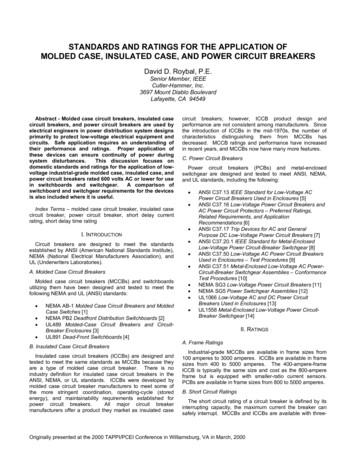
Transcription
STANDARDS AND RATINGS FOR THE APPLICATION OFMOLDED CASE, INSULATED CASE, AND POWER CIRCUIT BREAKERSDavid D. Roybal, P.E.Senior Member, IEEECutler-Hammer, Inc.3697 Mount Diablo BoulevardLafayette, CA 94549Abstract - Molded case circuit breakers, insulated casecircuit breakers, and power circuit breakers are used byelectrical engineers in power distribution system designsprimarily to protect low-voltage electrical equipment andcircuits. Safe application requires an understanding oftheir performance and ratings. Proper application ofthese devices can ensure continuity of power duringsystem disturbances.This discussion focuses ondomestic standards and ratings for the application of lowvoltage industrial-grade molded case, insulated case, andpower circuit breakers rated 600 volts AC or lower for usein switchboards and switchgear.A comparison ofswitchboard and switchgear requirements for the devicesis also included where it is useful.Index Terms – molded case circuit breaker, insulated casecircuit breaker, power circuit breaker, short delay currentrating, short delay time ratingI. INTRODUCTIONCircuit breakers are designed to meet the standardsestablished by ANSI (American National Standards Institute),NEMA (National Electrical Manufacturers Association), andUL (Underwriters Laboratories).A. Molded Case Circuit BreakersMolded case circuit breakers (MCCBs) and switchboardsutilizing them have been designed and tested to meet thefollowing NEMA and UL (ANSI) standards: NEMA AB-1 Molded Case Circuit Breakers and MoldedCase Switches [1]NEMA PB2 Deadfront Distribution Switchboards [2]UL489 Molded-Case Circuit Breakers and CircuitBreaker Enclosures [3]UL891 Dead-Front Switchboards [4]B. Insulated Case Circuit BreakersInsulated case circuit breakers (ICCBs) are designed andtested to meet the same standards as MCCBs because theyare a type of molded case circuit breaker. There is noindustry definition for insulated case circuit breakers in theANSI, NEMA, or UL standards. ICCBs were developed bymolded case circuit breaker manufacturers to meet some ofthe more stringent coordination, operating-cycle (storedenergy), and maintainability requirements established forpower circuit breakers.All major circuit breakermanufacturers offer a product they market as insulated casecircuit breakers; however, ICCB product design andperformance are not consistent among manufacturers. Sincethe introduction of ICCBs in the mid-1970s, the number ofcharacteristics distinguishing them from MCCBs hasdecreased. MCCB ratings and performance have increasedin recent years, and MCCBs now have many more features.C. Power Circuit BreakersPower circuit breakers (PCBs) and metal-enclosedswitchgear are designed and tested to meet ANSI, NEMA,and UL standards, including the following: ANSI C37.13 IEEE Standard for Low-Voltage ACPower Circuit Breakers Used in Enclosures [5]ANSI C37.16 Low-Voltage Power Circuit Breakers andAC Power Circuit Protectors – Preferred Ratings,Related Requirements, and ApplicationRecommendations [6]ANSI C37.17 Trip Devices for AC and GeneralPurpose DC Low-Voltage Power Circuit Breakers [7]ANSI C37.20.1 IEEE Standard for Metal-EnclosedLow-Voltage Power Circuit-Breaker Switchgear [8]ANSI C37.50 Low-Voltage AC Power Circuit BreakersUsed in Enclosures – Test Procedures [9]ANSI C37.51 Metal-Enclosed Low-Voltage AC PowerCircuit-Breaker Switchgear Assemblies – ConformanceTest Procedures [10]NEMA SG3 Low-Voltage Power Circuit Breakers [11]NEMA SG5 Power Switchgear Assemblies [12]UL1066 Low-Voltage AC and DC Power CircuitBreakers Used in Enclosures [13]UL1558 Metal-Enclosed Low-Voltage Power CircuitBreaker Switchgear [14]II. RATINGSA. Frame RatingsIndustrial-grade MCCBs are available in frame sizes from100 amperes to 3000 amperes. ICCBs are available in framesizes from 400 to 5000 amperes. The 400-ampere-frameICCB is typically the same size and cost as the 800-ampereframe but is equipped with smaller-ratio current sensors.PCBs are available in frame sizes from 800 to 5000 amperes.B. Short Circuit RatingsThe short circuit rating of a circuit breaker is defined by itsinterrupting capacity, the maximum current the breaker cansafely interrupt. MCCBs and ICCBs are available with three-Originally presented at the 2000 TAPPI/PCEI Conference in Williamsburg, VA in March, 2000
phase short circuit current ratings that vary based on thesystem voltage and the breaker design. The interruptingcapacity of most MCCBs is voltage dependent and at 480volts ranges from a low of 10 kA to a high of 100 kA. Somedesigns are available with integral current limiters for a ratingof 200 kA. At 480 volts, ICCBs have interrupting capacitiesranging from 35 kA to 150 kA and are not normally furnishedin combination with limiters.PCBs are also available with various interrupting capacities.In accordance with ANSI standards the preferred short timecurrent rating of PCBs without instantaneous trip units is thesame at 240, 480, and 600 volts while the short circuit currentrating of PCBs with instantaneous trip units is not. PCBinterrupting capacities range from 30 kA to 100 kA. PCBswith integral limiters can also be provided, increasing therating to 200 kA.C. Short Delay Current and Time RatingsThe short delay current rating and short delay time ratingdefine the ability of a circuit breaker to remain closed for atime interval under high fault current conditions. Short delaycurrent and time ratings allow an upstream breaker to remainclosed and power flow to a distribution system to bemaintained while a downstream breaker clears a faultedcircuit. This short delay capability is one of the maindistinctions between a molded case or insulated case circuitbreaker and a power circuit breaker.All MCCBs and ICCBs are provided with an instantaneoustrip function. Even when an adjustable instantaneous trip isnot furnished, the MCCB or ICCB will be equipped with a fixedinstantaneous override circuit set to the highest magnetic tripsetting available. The MCCB instantaneous override istypically fixed at a maximum of 10 to 13 times the breakerframe rating, and the maximum short delay time rating forcurrent magnitudes below the instantaneous trip value istypically 18 cycles. The instantaneous override trip level ofICCBs is higher than that of equivalent-size MCCBs. Themaximum short delay time rating for ICCBs is 30 cycles (1/2second). Because they trip with no intentional delay forcurrent magnitudes above their instantaneous trip setting,MCCBs and ICCBs have high interrupting capacities.However, selective coordination is sacrificed for currentmagnitudes in excess of the maximum short delay currentrating when breakers in series have instantaneous tripelements.Although PCB interrupting capacities are generally not ashigh as those of the highest-rated MCCBs and ICCBs, PCBsare capable of being applied without instantaneous trips.Their short delay current rating is equivalent to theirinterrupting current rating, and their maximum short delay timerating is 30 cycles. The ANSI test standards for PCBsactually require fault testing for a short delay time of 30-cycleduration, then a 15-second zero current interval followed byanother fault test for a short delay time of 30-cycle duration.This short delay current and time rating allows breakers inseries to be selectively coordinated. PCBs with adjustableinstantaneous trip elements are available, and some of thesedesigns have higher interrupting ratings than equivalentdesigns without an instantaneous trip.D. Test Power Factor (X/R)Circuit breakers are tested for a short circuit power factorbased on the interrupting rating and type of device. As shownin Table I, MCCBs, and therefore also ICCBs, have shortcircuit test power factors that range from 15% to 20% forinterrupting ratings above 20 kA, while all PCBs are tested fora short circuit power factor of 15% maximum. The lower theshort circuit test power factor, the more demanding the test.TABLE IMCCB/PCB SHORT CIRCUIT TEST POWER FACTORType ofCircuit BreakerInterruptingRating (kA)PowerFactorTest RangeX/R TestRangeMolded CaseMolded CaseMolded CaseLow-Voltage Power10 or lessover 10 to 20over 20all0.45 – 0.500.25 – 0.300.15 – 0.200.15 max.1.98 - 1.733.87 - 3.186.6 - 4.96.6 min.Power factor, cosine θ, is a mathematical relationshipbetween reactance (X) and resistance (R), so each test powerfactor has a specific corresponding test ratio X/R, or tangentθ. The lower the test power factor, the higher the X/R ratio. Xand R represent the total reactance and resistance from thefaulted point in the system back to the generating source.The structure of a typical asymmetrical current wave isshown in Fig. 1. The effect of reactance in an AC system is tocause the initial current to be high and then decay towardsteady-state value.The initial asymmetrical waveformbecomes symmetrical as the direct-current component of thefault current decays. The rate of decay depends on the X/Rratio of the circuit.The higher the X/R ratio, the greater the first peak value ofthe short circuit test current. The X/R ratio determines thedegree of asymmetry in the faulted circuit, or the maximumvalue by which the first half-cycle peak current exceeds thesteady state rms value of the fault current. The maximum rmsasymmetrical current is derived from the rms symmetricalcurrent and the DC component taken at the fault current peak.The actual degree of asymmetry depends on when the faultoccurs in the voltage wave.Fig. 1. Structure of an Asymmetrical Current Wave
TABLE IIMULTIPLYING FACTORS FOR CIRCUIT BREAKERINTERRUPTING rupting Rating 10 kA 10 kA 20 kA 20 kAAllLV 874If the calculated short circuit current X/R ratio is greaterthan the tested values of a device, a derating multiplyingfactor should be applied to the circuit breaker interruptingrating, as indicated in Table II.The peak multiplication factor times the rms symmetricalfault current provides the first half-cycle peak fault current.Fig. 2. Relation of X/R Ratio to Multiplication Factor [15]The relationship between the short circuit X/R ratio and thepeak multiplication factor is shown in Fig. 2.Most circuit breaker electronic trip units use peak sensingto determine the adjustable instantaneous pickup and thefixed instantaneous override circuit values. An MCCB and aPCB with identical published short delay current ratings willrespond differently to the same fault current based on theirindividual X/R ratio design test capabilities.This difference is important. A circuit breaker with aninterrupting capacity of 100,000 amperes rms symmetricaland a short delay current rating of 65,000 amperes based ona symmetrical wave (X/R 0) would have a first half-cyclepeak multiplying current of 1.41 and would begin to openinstantaneously for peak current values over 1.41 x 65,000amperes, or 91,650 amperes peak. If this circuit breaker wereapplied in an application that had an available fault current of50,000 amperes rms symmetrical and an X/R ratio of 6.6, thepeak multiplying factor would be 2.3 (see Fig. 2). The 50,000amperes rms symmetrical available fault current would have afirst half-cycle peak current of 2.3 x 50,000 amperes, or115,000 amperes.Since the available fault current of 115,000 amperes peakexceeds the breaker instantaneous override of 91,650amperes peak, the instantaneous override would open thedevice instantly (with no intentional delay) rather than allowthe circuit breaker short delay circuit to continue to time outand coordinate with downstream breakers. Note that, whilethe circuit breaker interrupting capacity is 100,000 amperesand the short delay current is 65,000 amperes, for thisapplication the breaker would trip with no intentional delay fora fault current of 50,000 amperes.
Time in SecondsMCCB200ADownstream MCCB 200A480V TH-MAG, LIFrame size: 250ATrip: 200AInst. PU: 10.0*T 2000AMCCB50ADownstream MCCB 50A480V TH-MAG, LIFrame size: 100ATrip: 50AInst. PU: Non-adjustableCurrent in Amperes x 10Fig. 3. Time-Current Curve with Upstream 800A PCBThe 800-ampere power circuit breaker in Fig. 3 has aninterrupting capacity and short delay rating based on a 15%test power factor (X/R test ratio of 6.6 and peak multiplyingfactor of 2.3) by ANSI standards. A PCB with an interruptingrating of 65,000 amperes rms symmetrical would be able towithstand, without tripping or damage, 30 cycles of faultcurrent with an initial peak of 149,500 amperes.Time in SecondsMCCB800ADownstream MCCB 50A480VFrame size: 100ATrip: 50AInst. PU: Non-adjustableMCCB50AE. System Coordination and SelectivityThe coordination capabilities of MCCBs are limited by theirinstantaneous trip characteristics. For overloads and lowmagnitude faults, the time and current settings of MCCBs canbe coordinated depending on their specific adjustments andthe available overcurrent. For high-magnitude faults,instantaneous trips generally cannot be coordinated, sincethere is no time delay for coordination purposes.ICCBs usually have higher short delay time capabilitiesthan most MCCBs, allowing them to be selectivelycoordinated for higher levels of fault current (up to the level atwhich they trip instantaneously).PCBs have the greatest capability for coordination for highmagnitude faults.They can be provided without aninstantaneous trip element, in which case their short delaytime capability allows engineers to specify settings that arefully selective. They can also be provided with instantaneoustrips where appropriate, such as for the direct feeding ofindividual transformer or motor loads.Upstream MCCB 800A480VFrame size: 800ASensor: 800LTPU: 1.0 f(S) 800ASTPU: 5.0 f(s) 4000AInst. Override 14,000ADownstream MCCB 200A480VFrame size: 250ATrip: 200AIns
ANSI C37.16 Low-Voltage Power Circuit Breakers and AC Power Circuit Protectors – Preferred Ratings, Related Requirements, and Application Recommendations [6] ANSI C37.17 Trip Devices for AC and General Purpose DC Low-Voltage Power Circuit Breakers [7] ANSI C37.20.1 IEEE Standard for Metal-Enclosed Low-Voltage Power Circuit-Breaker Switchgear [8] ANSI C37.50 Low-Voltage AC .


